10/06/2005
9/20/2005
Copyrights... again!
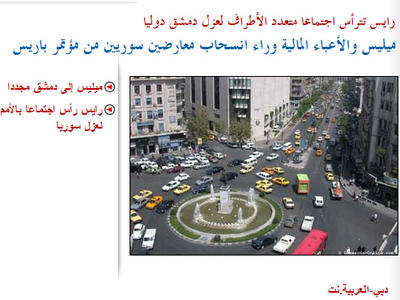 OK this has not become a copyright-watch blog... My studies have been keeping me away from blogging recently, but this morning I was browsing the web for home news and I discovered that the popular pan-Arab news wbesite Alarabiya.net republished a picture from Damascus-Online.com in a news piece about Syria and did not give any credit for it! I was with Amr when we took this picture of Youssef Al-Azmeh Square from atop the Muhafaza Building a couple of years ago (Remember Amr?) It's good they did not crop the part that has my stamp on the lower right corner, though you will need a microscope to read it!
OK this has not become a copyright-watch blog... My studies have been keeping me away from blogging recently, but this morning I was browsing the web for home news and I discovered that the popular pan-Arab news wbesite Alarabiya.net republished a picture from Damascus-Online.com in a news piece about Syria and did not give any credit for it! I was with Amr when we took this picture of Youssef Al-Azmeh Square from atop the Muhafaza Building a couple of years ago (Remember Amr?) It's good they did not crop the part that has my stamp on the lower right corner, though you will need a microscope to read it!Update (20/9): I wrote to Alarabiya. They apologized and removed the picture from the article.
Update (26/9): They used the same picture again in another news article. What's wrong with these guys?!
8/30/2005
Love...
"Love knows not its own depth until the hour of separation"
8/26/2005
Copyrights!
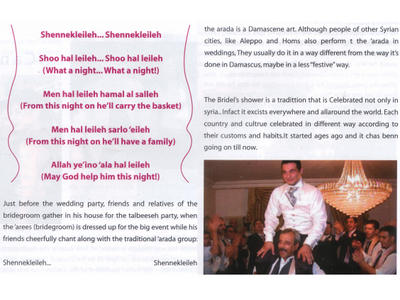 Without acquiring authorization or giving credit, the English version of Layalina Magazine has copied and pasted a post from the Damascene Blog in its latest edition. The Magazine also republished the picture in that same post and did not bother to mention the source anywhere in the article that carried the signature of the Magazine's managing editor.
Without acquiring authorization or giving credit, the English version of Layalina Magazine has copied and pasted a post from the Damascene Blog in its latest edition. The Magazine also republished the picture in that same post and did not bother to mention the source anywhere in the article that carried the signature of the Magazine's managing editor.
8/21/2005
Empty Tomb
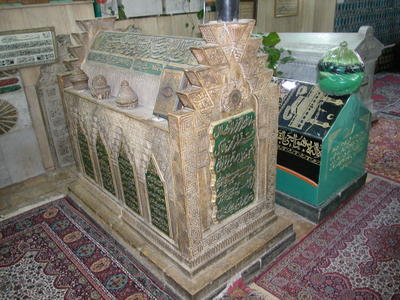 The empty tomb of Algerian national hero Abul Qadir Al-Jazairi (1808-1883), leader of the famous rebellion against the French invasion of Algeria in the mid-19th century. After losing several battles against Abdul Qadir, the French had to bring more enforcements into the country and practiced a scorched-earth policy to terrorize the population. Abdul Qadir was forced to surrender in 1847 and was later exiled to France. He remained there until 1852 when he moved to Bursa, Turkey, and then to Damascus in 1855.
The empty tomb of Algerian national hero Abul Qadir Al-Jazairi (1808-1883), leader of the famous rebellion against the French invasion of Algeria in the mid-19th century. After losing several battles against Abdul Qadir, the French had to bring more enforcements into the country and practiced a scorched-earth policy to terrorize the population. Abdul Qadir was forced to surrender in 1847 and was later exiled to France. He remained there until 1852 when he moved to Bursa, Turkey, and then to Damascus in 1855.In Damascus, he devoted himself to teaching and writing, and quickly gained popularity and respect among Syrians. In 1860, when sectarian violence broke out in Damascus, he provided refuge for more than 15,000 Christians who escaped the fighting, and helped to bring back peace and calm. He died in 1883 and was buried in the Mosque of Ibn Arabi in Damascus.
The remains of Abdul Qadir were brought back to Algeria on July 5, 1966, four years after Algerian independence and 136 years after the French invasion of Algeria.
8/11/2005
The Gorge
Maaloula is a small mountainous village located 50 km to the north-east of Damascus. It is famous for being one of the very few places in the world where people still speak Aramaic, the language of Jesus Christ. One of the highlights of Maaloula is the Fajj (gorge), a split that cuts through the mountains of Maaloula forming a beautiful narrow corridor. It is believed that the fajj is related to the story of St. Thecla (Arabic Taqla), the first girl martyr in Christianity. After converting to Christianity, Thecla was prosecuted by her family and by the Roman authorities. She was being chased by Roman soldiers when she faced a huge mountain, a dead end with no chances for escape. She prayed to God to save her and her prayer was miraculously answered when the rocks were split, forming a narrow passage: The fajj. This is where the village probably derives its name from; the word Maaloula in Aramaic means 'entrance'.
8/10/2005
Blogging Survey
I got this from a friend:
I'm currently doing some research for my Masters about blogging in Lebanon, Syria and Jordan at the University of Westminster. I've just designed a questionnaire and would be grateful if you could fill it on (its for anyone of the above origins or living in these countries). It only takes about 8 minutes.
All your responses and any comments will be treated with the utmost confidentiality. The results of this research should be very exciting and, by the end of august, I will be sharing them with everyone. If you have questions at any time about the survey or the procedures, you may contact, myself, Maha Taki on +44(0)7916161035 or email me at the email mahataki(at)gmail.com.
8/03/2005
Alley of Waterwheels

The oldest and only surviving waterwheel in Damascus is in As-Salhieh district on the slopes of Mount Qassiyoun. This water-raising device dates back to the Ayubid era and was designed by Badi' Al-Zaman Al Jazari
The waterwheel used to carry water from Yazid River to a 12-meter-high canal ending in the nearby Al-Bimaristan Al-Qaymari Hospital. It remained in use until the early 1970s. Many other waterwheels existed in the area, which is still known as Ziqaq Al-Nawa'ir (Alley of Waterwheels).
Update: My friend GottfriedStutz left some very informative comments about Al-Jazari.
7/31/2005
Take Off!
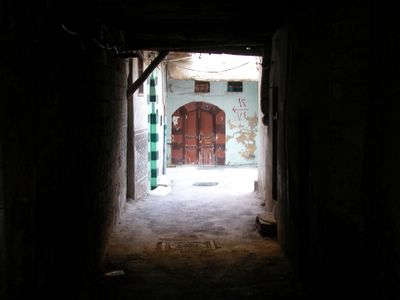
Oh Damascus, the summer is back again.
And my wings are, too.
My yearning to you cries out: "Take off!"
And the wind calls upon me.
The voices of my friends,
Her eyes,
And the promise of a possible tomorrow...
Everything I love
Has stolen sleep from my eyes
Then went to sleep.
From a song by Fairouz to the lyrics of Said Akel.
7/24/2005
Suicidal Battle
Translation:
Maysaloun Street: In memory of the Battle of Maysaloun, a suicidal battle fought on July 24th, 1920 to defend Damascus against French forces. Defense Minister Youssef Al-Azmah was martyred during the fighting.Although he knew that his poorly-equipped army will be overwhelmed by the French, Youssef Al-Azmah, Defense Minister of then newly independent Syria, did not want Damascus to be an easy get for General Gouraud, so he led 4000 men to fight the French army at Maysaloun, 25 km to the west of Damascus. The battle lasted for a few hours, the Syrian army was defeated and Al-Azmah was killed. For Syrians, he became a symbol of courage, sacrifice and dignity.
7/20/2005
Golden Flowing
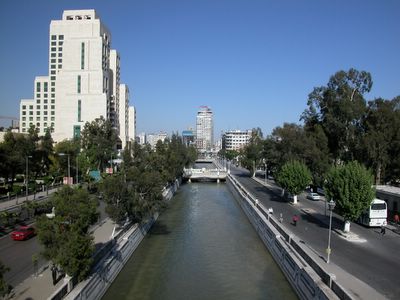
River Barada in Downtown Damascus.
Barada used to be known as the "artery of Damascus." It irrigated the oasis of Damascus, which largely consisted of the beautiful orchards of Al-Ghouta. In old times, the river was famed for its purity and crystal-clear water. The Greeks called it Chrysorrhoas: the golden flowing. There is even a biblical reference to this reputation: In the old Testament, when Naaman the Syrian was asked to wash in the Jordan, a muddy river, he complained saying:
"Are not Abana and Pharpar, rivers of Damascus, better than all the rivers of Israel?"Abana is today's Barada, while Pharpar is probably either Al-Aa'waj river which also flows down Mount Hermon to Damascus, or Taura, a branch of Barada.
During the second half of the 20th century, Damascus quickly expanded. It's now home for almost 4 million people. The quick expansion of the city, the increasing consumption of water and the destruction of Ghouta by concrete residential blocks, resulted in the eventual death of Barada. The river that used to flood central Damascus every year is now almost completely dry in Summer. It flows at its highest level for a short time after the end of the rain- and snowfall season. This picture was taken in March.
Back to life!
6/07/2005
5/27/2005
Religion of Love
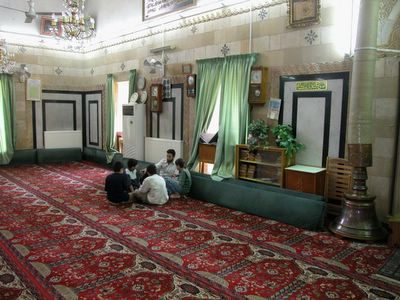
A religious lesson at the Mosque of Ibn Al-Arabi in Salhieh, Damascus.
Muhyiddin Ibn Arabi (1165-1240) is one of the most famous Muslim philosophers. He was born in southern Spain and lived during the golden era of openness and tolerance in Arab-ruled Andalusia. He spent years traveling around the Arab world before finally settling in Damascus, where he completed his greatest book Al-Futuhat Al-Makkiyyah (Meccan Revelations), which is an encyclopedia of Sufism (Islamic mysticism) and Sufi teachings. He was buried in Damascus; and the Mosque, pictured above, was built in his honor by Ottoman Sultan Selim I in 1516.
Throughout his life, Ibn Arabi preached tolerance among all faiths. In one of his most famous poems, he considers his heart "a center of love":
O Marvel! a garden amidst the flames.
My heart has become capable of every form:
It is a pasture for gazelles and a convent for Christian monks,
and a temple for idols and the pilgrim's Kaa'ba,
and the tables of the Torah and the book of the Quran.
I follow the religion of Love:
Whatever way Love's camels take,
that's my religion and my faith.
5/25/2005
Founding Father

Rida Said Street leading to the Headquarters of Damascus University.
Rida Said (1876-1945) is one of the founders of Damascus University. He studied medicine in Turkey and served in the Turkish Army during the Balkan War. He was the mayor of Damascus in the hardship days of World War I, during which most schools and colleges in Damascus were closed. After the War, he lobbied for the revival of educational institutes in Damascus, and in 1919 he became the President of the newly established Syrian University, the first state-run university in the Arab World. He kept the position until 1936.
The pink building in the background, to the left of the University Headquarters, is that of the old National Hospital (dating back to 1899). A few years ago, it was renovated and turned into a conference center that also carries the name of Rida Said.



